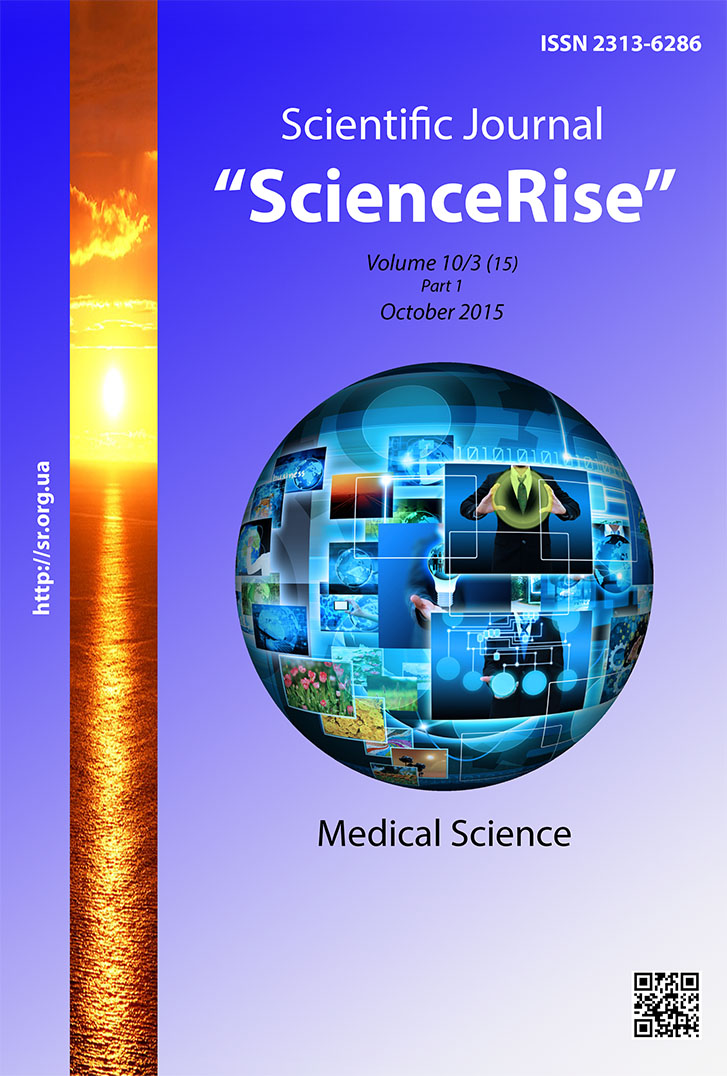Обґрунтування ефективності використання антисептика «октенісепт®» в лікуванні нагноєння епітеліального куприкового ходу
DOI:
https://doi.org/10.15587/2313-8416.2015.52179Ключевые слова:
епітеліальний куприковий хід, нагноєння, золотистий стафілокок, антисептик, обсіменіння, перифокальна тканина, «Октенісепт®»Аннотация
Робота присвячена вивченню видового та популяційного рівня мікробної контамінації в гнійному вогнищі, в перифокальних тканинах у хворих з нагноєнням епітеліального куприкового ходу, використанням в комплексному лікуванні найбільш ефективних розчинів антисептиків. Встановлено, що основними мікроорганізмами є золотистий стафілокок, зустрічаються умовно-патогенні ешерихії (E.coli), епідермальний стафілокок. Найбільш чутливими мікроорганізми виявилися до антисептика «Октенісепт®»
Библиографические ссылки
Vorobey, A. A., Rimzha, M. I., Denisenko, V. L., Vorobey, A. V. (2005). Optimizatsiya lecheniya epitelialnogo kopchikovogo hoda, oslozhnennogo abstsessom. Koloproktologiya, 3, 3–7.
Lavreshin, P. M., Muravev, A. V., Gobedzhishvili, V. K. (2000). Optimizatsiya metodov lecheniya epitelialnogo kopchikovogo hoda. Problemyi proktologii, 17, 126–131.
Dultsev, Yu. V., Ryivkin, V. L. (1988). Epitelialnyiy kopchikovyiy hod. Moscow: Meditsina, 198.
Niyazov, A. Sh. (2009). Rezultatyi posleoperatsionnoy effektivnosti hirurgicheskogo lecheniya ostrogo vospaleniya epitelialno-kopchikovogo hoda Sovremennyie dostizheniya Azerbaydzhanskoy meditsinyi, 9, 65–69.
Datsenko, B. M. (2006). Ostroe nagnoenie epitelialnogo kopchikovogo hoda. Kharkiv, 160.
Abdul-Ghani, A., Abdul-Ghani, A., Clark, C. I. (2006). Day-Care Surgery for Pilonidal Sinus. Annals, 88 (7), 656–658. doi: 10.1308/003588406x149255
Thompson, M. R., Senapati, A., Kitchen, P. R. B. (2010). Pilonidal Sinus Disease. Anorectal and Colonic Diseases, 373–386. doi: 10.1007/978-3-540-69419-9_23
Ackerman, L. L., Menezes, A. H. (2003). Spinal Congenital Dermal Sinuses: A 30-Year Experience. PEDIATRICS, 112 (3), 641–647. doi: 10.1542/peds.112.3.641
Doll, D., Matevossian, E., Wietelmann, K., Evers, T., Kriner, M.,Petersen, S. (2009). Family History of Pilonidal Sinus Predisposes to Earlier Onset of Disease and a 50 % Long-Term Recurrence Rate. Diseases of the Colon & Rectum, 52 (9), 1610–1615. doi: 10.1007/dcr.0b013e3181a87607
Ersoy, O. F., Kayaoglu, H. A., Ozkan, N., Celik, A., Karaca, S., Ozum, T. (2007). Comparison of Different Surgical Options in the Treatment of Pilonidal Disease: Retrospective Analysis of 175 Patients. The Kaohsiung Journal of Medical Sciences, 23 (2), 67–70. doi: 10.1016/s1607-551x(09)70377-8
Müller, K., Marti, L., Tarantino, I., Jayne, D. G., Wolff, K., Hetzer, F. H. (2011). Prospective Analysis of Cosmesis, Morbidity, and Patient Satisfaction Following Limberg Flap for the Treatment of Sacrococcygeal Pilonidal Sinus. Diseases of the Colon & Rectum, 54 (4), 487–494. doi: 10.1007/dcr.0b013e3182051d96
Nyiazov, A. Sh. (2009). Rezultatyi mykrobyolohycheskykh yssledovanyi u bolnyikh s ostryim vospalenyem okolopararektalnoi kletchatky. Zdorovye, 9, 46–51.
Hassan, M., Refaat, A., Aiad, A. et. al (2007). Pilonidal disease simple pathogenesis but complex management. The Egyptian Journal of Hospital Medicine, 29, 726–731.
Miocinovic, M., Horzic, M., Bunoza, D. (2001). The prevalence of anaerobic infection in pilonidal sinus of the sacrococcygeal region and its effect on the complications. Acta. Med. Croatica, 55 (2), 87–90.
Загрузки
Опубликован
Выпуск
Раздел
Лицензия
Copyright (c) 2015 Олег Богданович Русак

Это произведение доступно по лицензии Creative Commons «Attribution» («Атрибуция») 4.0 Всемирная.
Наше издание использует положения об авторских правах Creative Commons CC BY для журналов открытого доступа.
Авторы, которые публикуются в этом журнале, соглашаются со следующими условиями:
1. Авторы оставляют за собой право на авторство своей работы и передают журналу право первой публикации этой работы на условиях лицензии Creative Commons CC BY, которая позволяет другим лицам свободно распространять опубликованную работу с обязательной ссылкой на авторов оригинальной работы и первую публикацию работы в этом журнале.
2. Авторы имеют право заключать самостоятельные дополнительные соглашения, которые касаются неэксклюзивного распространения работы в том виде, в котором она была опубликована этим журналом (например, размещать работу в электронном хранилище учреждения или публиковать в составе монографии), при условии сохранения ссылки на первую публикацию работы в этом журнале .

